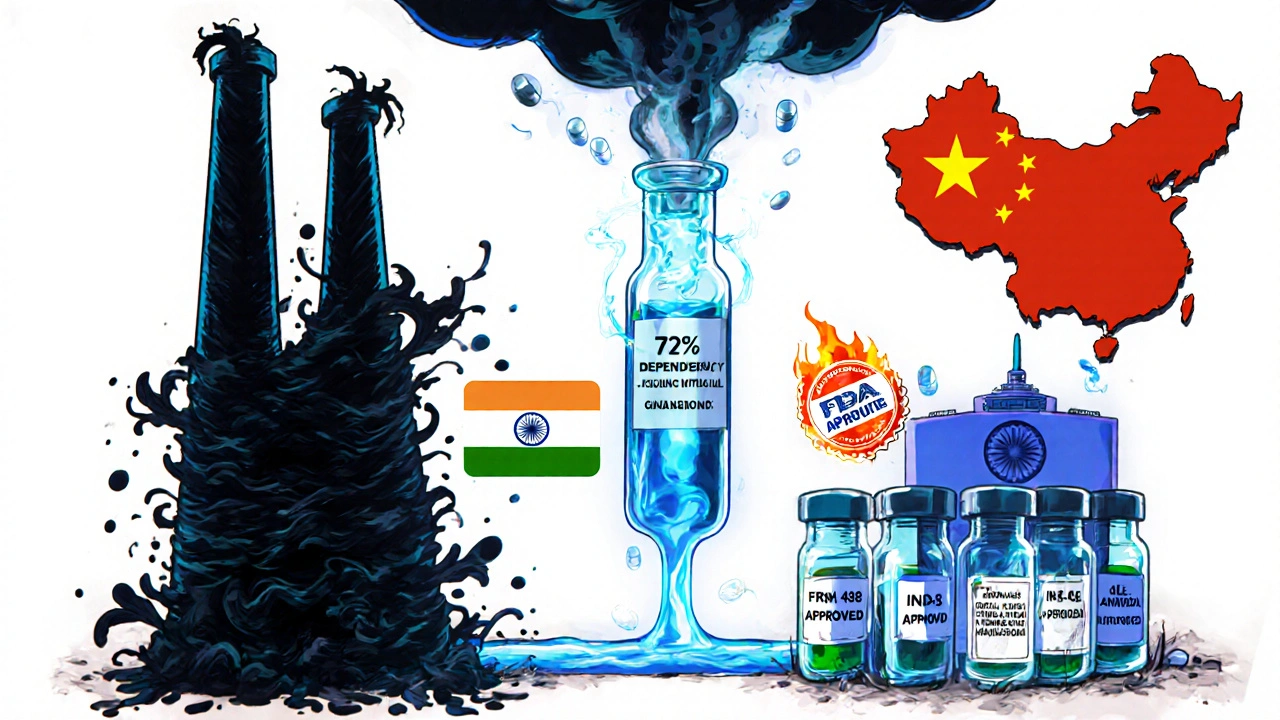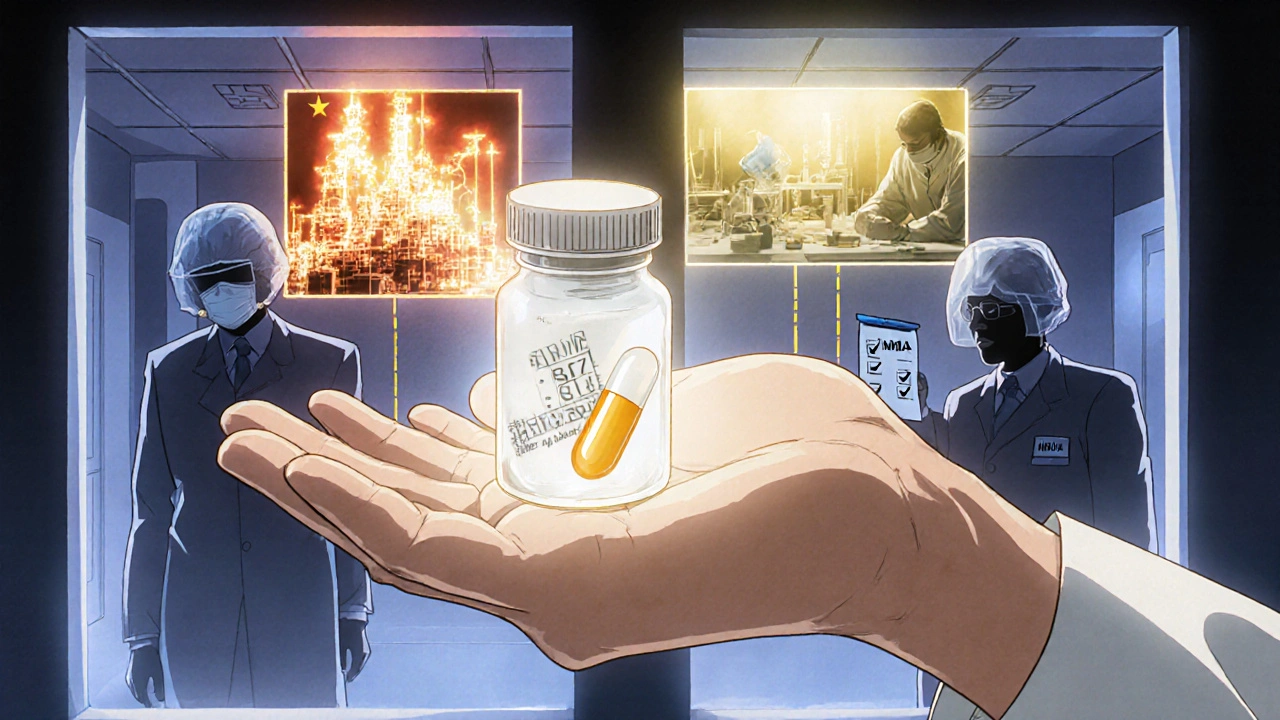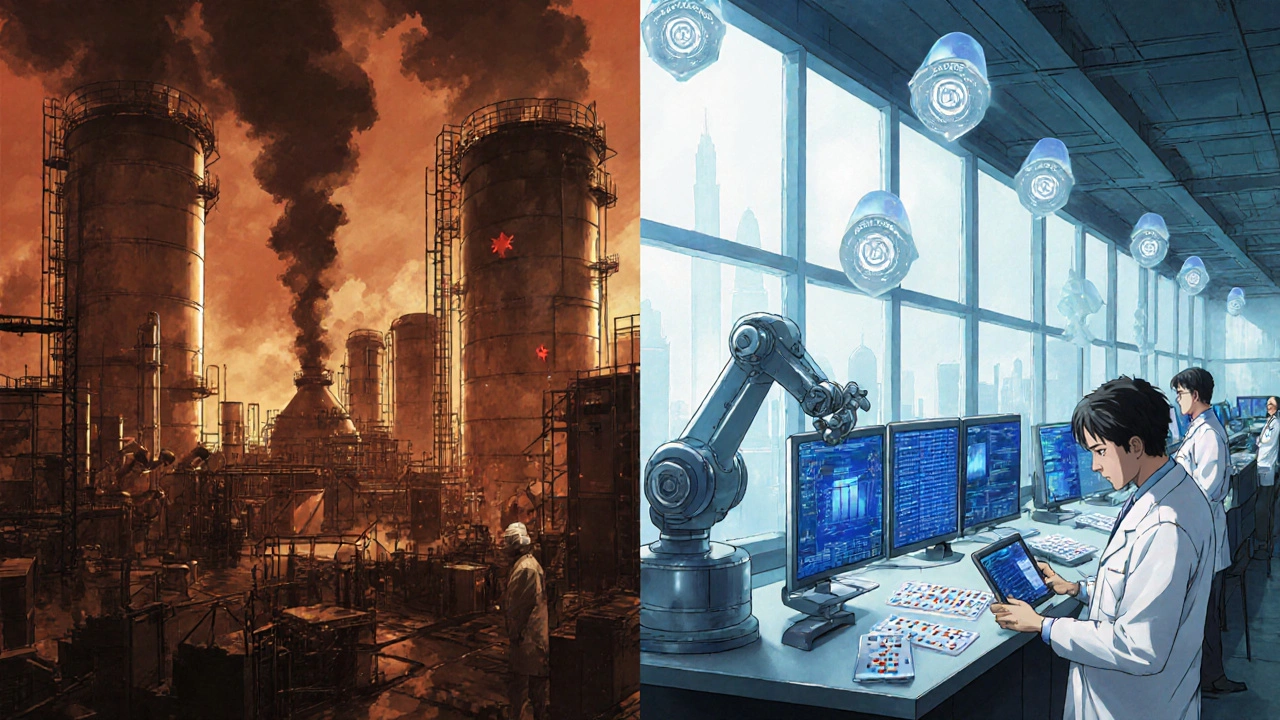When you take a pill for high blood pressure or antibiotics, chances are it was made in China or India. These two countries supply over 80% of the world’s active pharmaceutical ingredients (APIs) and most generic drugs. But behind the low prices and fast delivery lies a complex reality: China and India manufacturing carry very different risks - and the FDA watches them in very different ways.
Why the FDA Cares So Much
The FDA doesn’t just inspect factories for fun. Every batch of medicine that enters the U.S. must meet strict standards under 21 CFR Part 211. A single contaminated batch can cause deaths. In 2008, heparin from China was tainted with a toxic substance, leading to over 100 deaths. That’s why the FDA sends inspectors to manufacturing sites - and why they’re spending more time in China than ever before. In 2023, 37% of Chinese pharmaceutical facilities faced FDA import alerts - warnings that a product might be unsafe or mislabeled. For Indian facilities, that number was just 18%. That’s not a coincidence. It’s the result of years of regulatory evolution, cultural alignment, and investment in quality systems.India’s Edge: Compliance Over Scale
India has over 100 FDA-approved manufacturing plants. China has 28. That’s not a typo. India leads in certified capacity by a wide margin. Why? Because Indian pharma companies learned early that compliance isn’t optional - it’s the price of entry into Western markets. Companies like Dr. Reddy’s, Sun Pharma, and Cipla built their businesses on supplying generic drugs to the U.S. and Europe. To do that, they had to pass FDA inspections - repeatedly. Many invested in digital quality systems that track every step of production, from raw materials to packaging. Bain & Company found that over 50% of Asia-Pacific contract research organizations (CROs) are based in India, not China. The result? Fewer Form 483 observations - the FDA’s official list of violations - during inspections. Indian plants see about 30% fewer issues than Chinese ones. That means fewer delays, fewer recalls, and more trust from buyers.China’s Strength: Volume and Cost
China dominates the API market. It produces an estimated 80% of the world’s generic drug ingredients. That’s because China built massive, vertically integrated factories that can churn out tons of chemicals at a fraction of the cost. But cost doesn’t always mean quality. Smaller Chinese suppliers often cut corners to stay competitive. The FDA has caught multiple facilities falsifying data, using unapproved raw materials, or skipping stability tests. These aren’t rumors - they’re documented in public inspection reports. China’s government has pushed hard to upgrade standards. Factories now claim ISO, CE, and RoHS certifications. But certification doesn’t always mean consistent quality. A factory might pass an inspection one month and fail the next. The system is less predictable. And with rising labor costs and tighter U.S. scrutiny, China’s cost advantage is shrinking.
The Hidden Weakness in India’s Model
Here’s the uncomfortable truth: India depends on China for its own medicines. In FY2024, India imported 72% of its bulk drug ingredients from China - up from 66% just two years earlier. That means even if your drug was made in India, the key chemical inside likely came from China. This creates a single point of failure. If China restricts exports - for political, economic, or health reasons - India’s entire supply chain could stall. U.S. pharmaceutical companies are now scrambling to fix this. One sourcing executive told Bain & Company: “We’re trying to diversify, but we’re stuck. We can’t make APIs without China.” India’s “Make in India” program is trying to fix this. The government has allocated nearly $3 billion in incentives to build domestic API production. But it’s a long game. Building a plant that meets FDA standards takes years. And right now, China still has the scale, the infrastructure, and the chemical expertise.What the ‘China+1’ Strategy Really Means
Since 2020, many U.S. drugmakers have adopted a “China+1” strategy: keep some production in China, but move at least one major line to India. Why? Because India offers something China can’t: reliability. When you’re making medicine for millions of patients, you don’t want to gamble on inconsistent quality. Indian factories have a track record. They speak English. Their regulatory teams understand FDA expectations. And their workforce is trained on U.S. standards. This isn’t about patriotism. It’s about risk management. A single recall can cost a company hundreds of millions - and destroy brand trust. India reduces that risk. But it’s not perfect. Setting up in India takes 6 to 9 months just to get compliant. In China, you might get started in 3 to 6 months - but then you’ll likely need to spend another 6 months fixing problems the FDA finds later.
The Future: Biologics and Beyond
The next frontier isn’t just generic pills. It’s biologics - complex drugs made from living cells, like insulin or cancer treatments. These are harder to make, harder to copy, and far more profitable. China is leading here. Its biopharmaceutical market is growing at 19.3% per year. India’s is growing faster - 22% - but from a much smaller base. India still focuses on cheap generics. China is moving up the value chain. If India wants to stay ahead long-term, it needs to stop being just a copycat. It needs to invest in innovation. Right now, most of India’s government incentives go to generic production. Experts say that’s a mistake. “We need to allocate more funding to biosimilars, cell therapies, and gene therapies,” says a Bain & Company analyst. “Otherwise, we’ll just be replacing one dependency - for APIs - with another - for advanced drugs.”What This Means for You
You might not care where your medicine comes from. But you should. If your drug is recalled, it’s your health on the line. If your prescription gets delayed, it’s your life that’s disrupted. The FDA’s inspections are your safety net. But they’re not perfect. They inspect only a fraction of factories each year. That means the system relies heavily on manufacturers doing the right thing - even when no one’s watching. India’s model is more trustworthy. China’s is more efficient. But both are part of the same global supply chain. And right now, the world is betting on India to be the safer, more reliable partner. The lesson? Don’t assume all generics are equal. Ask your pharmacist: “Is this made in India or China?” It’s not a question you should feel awkward asking. It’s a question that could save your life.Why does the FDA inspect Indian factories less than Chinese ones?
The FDA inspects Indian facilities less often because they have a stronger track record of compliance. Between 2020 and 2023, Indian plants received 30% fewer Form 483 observations - official notices of violations - than Chinese ones. Indian manufacturers have invested heavily in digital quality systems, staff training, and adherence to FDA standards since the 1990s, making them more predictable. China’s factories, while improving, still show higher rates of data falsification, poor sanitation, and unapproved processes, leading to more frequent inspections and import alerts.
Is medicine made in India safer than medicine made in China?
On average, yes - but it’s not guaranteed. Indian-made drugs are more likely to meet FDA standards because manufacturers have spent decades tailoring their processes to Western regulations. Over 100 Indian plants are FDA-approved, compared to 28 in China. However, quality varies by company, not just country. A small, poorly managed factory in India can still produce unsafe drugs. The key difference is consistency: Indian firms are more likely to maintain quality over time, while Chinese facilities often show wide swings between inspections.
Why does India rely so heavily on China for drug ingredients?
India has focused on packaging and formulating drugs rather than producing the raw chemicals (APIs) themselves. China built massive, low-cost chemical plants decades ago and now controls nearly 80% of the global API market. India’s domestic API industry is underdeveloped, and shifting production there requires billions in investment and years of regulatory alignment. Even with India’s “Make in India” program, it will take over a decade to reduce dependence. For now, 72% of India’s APIs come from China - making the entire supply chain vulnerable to disruptions.
What is the ‘China+1’ strategy in pharma manufacturing?
The ‘China+1’ strategy means pharmaceutical companies keep some manufacturing in China but move at least one critical production line to another country - usually India - to reduce risk. This isn’t about abandoning China; it’s about avoiding a single point of failure. If a political conflict, natural disaster, or regulatory crackdown shuts down a Chinese factory, having a backup in India ensures medicine continues to flow. Companies choose India because of its proven compliance, English-speaking workforce, and familiarity with FDA rules.
Can I trust generic drugs from India or China?
Yes - if they’re made by reputable companies and approved by the FDA. Generic drugs, whether from India or China, must meet the same standards as brand-name drugs to be sold in the U.S. The FDA requires them to have the same active ingredient, strength, dosage form, and bioavailability. But trust comes from transparency. Look for brands with a history of FDA approvals. Avoid unknown suppliers or online pharmacies that don’t list the manufacturer. If a drug is FDA-approved, it’s safe - regardless of where it was made.
Are U.S. drug companies moving away from China entirely?
No - but they’re reducing reliance. China still produces the cheapest and most abundant APIs. Many U.S. companies still source basic ingredients from China because switching is expensive and slow. However, for finished drugs - especially those used in hospitals or for chronic conditions - companies are shifting production to India. The goal isn’t to eliminate China, but to diversify. By 2030, China’s share of outsourced pharma manufacturing is expected to drop from 25% to around 15%, while India’s share will rise.


